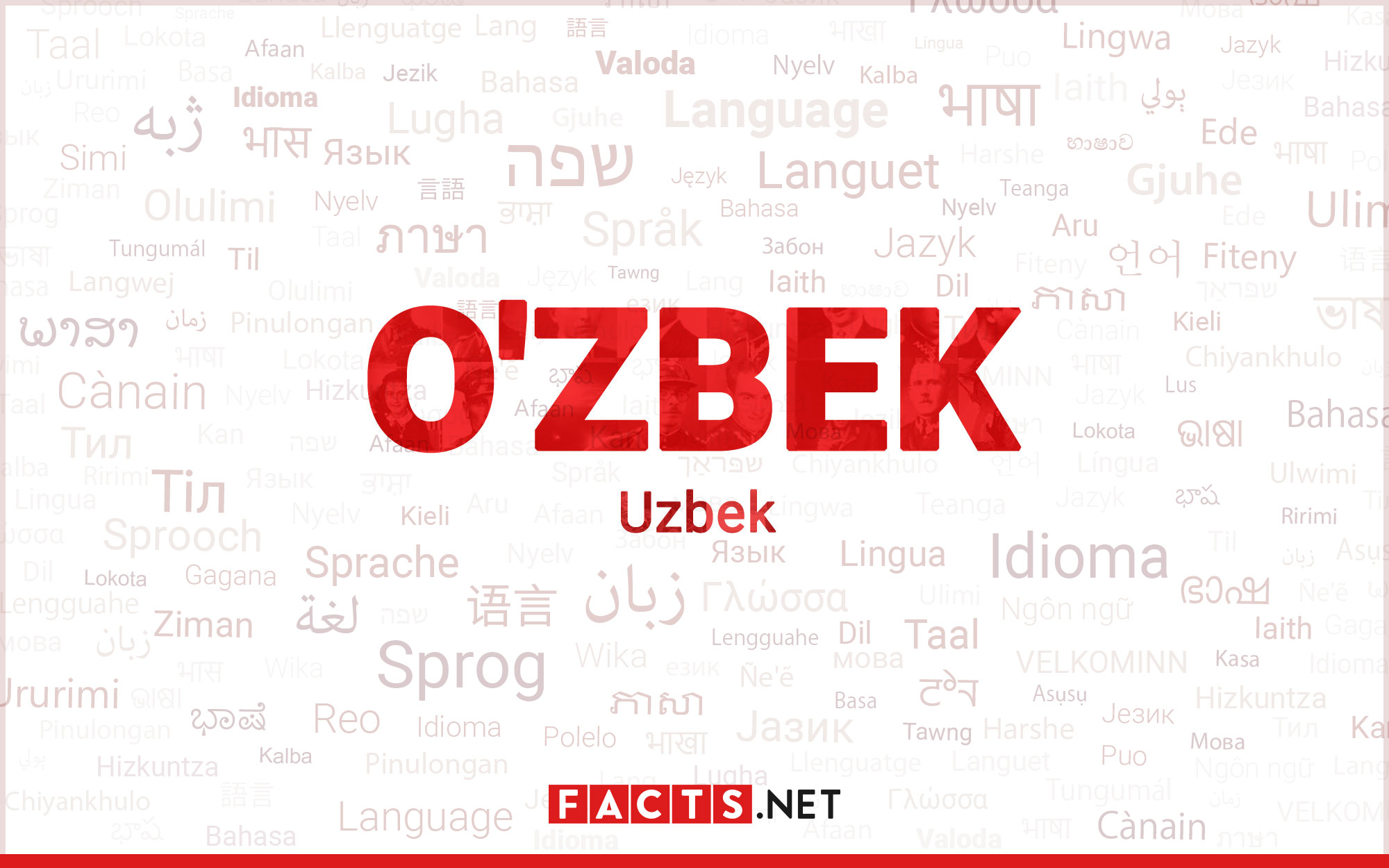
Uzbek, a Turkic language spoken by over 30 million people, is rich in history, culture, and linguistic diversity. As the official language of Uzbekistan, it holds a special place in the hearts of its speakers and those intrigued by its unique characteristics. In this article, we'll delve into 15 extraordinary facts about the Uzbek language, shedding light on its origins, influences, and fascinating linguistic features. From its ties to the ancient Silk Road to its intricate grammar and script, Uzbek has a story to tell that captivates language enthusiasts and historians alike. Join us on a journey through the captivating world of Uzbek, where each fact unveils a new layer of its complexity and beauty. Whether you're a language aficionado or simply curious about the diverse tapestry of human communication, these extraordinary facts will deepen your appreciation for the Uzbek language and its enduring legacy.
Key Takeaways:
- Uzbek language, the pride of Uzbekistan, has a rich history and cultural significance, with influences from various civilizations and a transition to the Latin script in 1993.
- With over 32 million speakers worldwide, Uzbek serves as a unifying force, preserving oral traditions, and fostering national pride and unity in Uzbekistan.
The Uzbek language is the official language of Uzbekistan.
Spoken by over 32 million people worldwide, Uzbek is the official language of Uzbekistan and holds significant cultural and historical importance. The language has evolved over centuries, influenced by various civilizations and empires that have shaped the region's identity.
Uzbek belongs to the Turkic language family.
Belonging to the Turkic language family, Uzbek shares linguistic ties with other Turkic languages such as Turkish, Kazakh, and Turkmen. This connection provides a rich tapestry of shared vocabulary and grammatical structures, offering insights into the historical and cultural exchanges between diverse Turkic communities.
The Uzbek alphabet underwent a transformation from Cyrillic to Latin script.
In a monumental linguistic reform, Uzbek transitioned from the Cyrillic script to the Latin alphabet in 1993, marking a significant shift in the country's cultural and educational landscape. This transition aimed to revive Uzbek identity and strengthen ties with Turkic-speaking nations while embracing modern communication standards.
The Uzbek language has borrowed words from Arabic and Persian.
Throughout its evolution, Uzbek has assimilated vocabulary from Arabic and Persian, reflecting the historical influence of Islamic civilization in the region. These linguistic borrowings enrich the language and offer a glimpse into the cultural and intellectual exchanges that have shaped Uzbek identity.
Uzbek exhibits dialectal variations across different regions.
Within Uzbekistan and neighboring regions, distinct dialectal variations of the language exist, reflecting the diverse cultural and geographical landscapes. These variations contribute to the linguistic tapestry of Uzbek and highlight the dynamic nature of language within specific communities.
Uzbek literature boasts a rich heritage of poetry and prose.
Uzbek literature encompasses a wealth of poetic and prose works, reflecting the cultural and artistic achievements of the Uzbek people. From classical masterpieces to contemporary writings, Uzbek literature stands as a testament to the language's expressive capabilities and its enduring impact on the country's cultural identity.
The Uzbek language serves as a symbol of national pride and unity.
As the official language of Uzbekistan, Uzbek plays a crucial role in fostering national pride and unity among its speakers. It serves as a unifying force, connecting individuals across diverse ethnic and regional backgrounds, and reinforcing a shared sense of identity and belonging.
Uzbek is characterized by vowel harmony and agglutinative grammar.
Linguistically, Uzbek is known for its vowel harmony and agglutinative grammar, where suffixes are added to root words to convey various grammatical functions. This unique feature contributes to the language's distinct phonological and morphological structure, setting it apart within the Turkic language family.
The Uzbek language has been influenced by Russian during the Soviet era.
During the Soviet era, the Uzbek language experienced significant influence from Russian, leading to the incorporation of Russian loanwords and expressions into the lexicon. This historical influence underscores the dynamic nature of language and its capacity to adapt to changing sociopolitical landscapes.
Uzbek serves as a gateway to Central Asian culture and heritage.
As a key component of Central Asian heritage, Uzbek provides a gateway to the region's rich cultural tapestry, encompassing traditions, folklore, and historical narratives. Through the medium of Uzbek, individuals can delve into the diverse cultural expressions that define Central Asia's vibrant identity.
The preservation of Uzbek language and culture is a national priority.
Uzbekistan places a strong emphasis on preserving and promoting the Uzbek language and cultural heritage, recognizing its intrinsic value in shaping national identity and fostering intergenerational connections. This commitment underscores the enduring significance of language in preserving historical legacies.
Uzbek language education is integral to the country's educational system.
Within Uzbekistan, language education plays a central role in the national curriculum, emphasizing the importance of linguistic proficiency and cultural understanding. This educational focus reflects the nation's dedication to nurturing linguistic competence and preserving the richness of the Uzbek language.
Uzbek serves as a vehicle for preserving oral traditions and folklore.
Through the medium of Uzbek, oral traditions, folklore, and storytelling are passed down through generations, preserving the collective wisdom and cultural narratives of the Uzbek people. The language serves as a conduit for transmitting cultural heritage, fostering a sense of continuity and shared identity.
The digital landscape has facilitated the proliferation of Uzbek language content.
With the advent of digital communication and media platforms, the Uzbek language has found new avenues for expression and dissemination. From online publications to social media content, the digital sphere has empowered the proliferation of Uzbek language content, contributing to its visibility and accessibility.
The global diaspora sustains the vitality of the Uzbek language.
Beyond Uzbekistan's borders, a vibrant global diaspora actively sustains the vitality of the Uzbek language, maintaining linguistic connections and cultural traditions across diverse geographical contexts. This diasporic network serves as a testament to the enduring significance of the Uzbek language in fostering transnational bonds and preserving heritage.
The Uzbek language stands as a testament to the rich tapestry of Central Asian culture, embodying centuries of historical, linguistic, and artistic evolution. As the official language of Uzbekistan, it serves as a unifying force, fostering national pride and preserving the diverse cultural expressions that define the region's identity. With its transition to the Latin script and its enduring literary heritage, Uzbek continues to thrive as a symbol of cultural resilience and linguistic vitality, shaping the narratives of past, present, and future generations.
Conclusion
In conclusion, Uzbek is a fascinating language with a rich history and unique linguistic features. Its status as one of the official languages of Uzbekistan and its widespread use by the Uzbek diaspora highlight its cultural significance. The script reform, which transitioned Uzbek from the Cyrillic to the Latin alphabet, reflects the language's adaptability and forward-looking nature. The diverse influences that have shaped Uzbek vocabulary and grammar contribute to its complexity and depth. As Uzbek continues to evolve and thrive in the modern world, it remains an essential element of Uzbek identity and heritage, serving as a testament to the resilience and vitality of the Uzbek language.
FAQs
What are the main influences on the Uzbek language?
The Uzbek language has been influenced by various languages, including Persian, Arabic, Russian, and Turkic languages. These influences have contributed to the rich vocabulary and diverse linguistic features of Uzbek.
Is Uzbek a difficult language to learn?
Uzbek, like any language, presents its own challenges, but with dedication and practice, it can be mastered. Its unique grammar and script may require some adjustment for learners, but the rewards of delving into this vibrant language are undoubtedly worth the effort.
Uzbek's fascinating linguistic journey mirrors Turkic languages' rich tapestry. Central Asia's cultural heartbeat resonates through Uzbek's melodic tones. Uzbekistan's national identity finds expression in its language's enduring legacy.
Was this page helpful?
Our commitment to delivering trustworthy and engaging content is at the heart of what we do. Each fact on our site is contributed by real users like you, bringing a wealth of diverse insights and information. To ensure the highest standards of accuracy and reliability, our dedicated editors meticulously review each submission. This process guarantees that the facts we share are not only fascinating but also credible. Trust in our commitment to quality and authenticity as you explore and learn with us.


